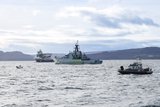Firing trials of Sea Ceptor complete
The Royal Navy has successfully completed First of Class firing trials of the Sea Ceptor air defence system on board HMS Argyll, MBDA announced on 20 December.
These final qualification firings saw Sea Ceptor tested against complex scenarios, including multiple simultaneous threats.
Following the completion of Sea Ceptor’s development testing on HMS Argyll, the weapon system is now being rolled out to the Royal Navy’s other Type 23 frigates, where it will replace the Sea Wolf weapon system. The first of a series of installation test firings has been successfully completed on HMS Westminster. Each Sea Ceptor platform will similarly complete an installation test firing in due course as they prepare to re-join frontline service after their refits.
The Sea Ceptor system, which uses MBDA’s Common Anti-air Modular Missile (CAMM), features a powerful rocket motor that provides double the range of Sea Wolf and an active radar-seeker that allows the missile to engage targets without the need for complex and costly target illuminators.
Nick Neale, manager for Sea Ceptor programme at MBDA, said: ‘The performance and capabilities of Sea Ceptor have been fully demonstrated in these trials by the Royal Navy. Recognising the complexity of the new system, the consistent level of success achieved is significant and testament to the quality of MBDA’s verification and validation process.’
More from Naval Warfare
-
![Indo Pacific 2025: Australian Defence Force sets its sights on autonomy]()
Indo Pacific 2025: Australian Defence Force sets its sights on autonomy
Multiple autonomous systems and technologies were on display at this year’s Indo Pacific, but questions remain over how the Australian Department of Defence will balance the books.
-
![How the UK Royal Navy is powering up its hybrid fleet to combat new threats]()
How the UK Royal Navy is powering up its hybrid fleet to combat new threats
Since it announced its move towards a new “hybrid navy” earlier this year, the force has announced a number of new uncrewed technologies in the works.
-
![US and UK to begin Trident II D5 Increment 8 in October 2026]()
US and UK to begin Trident II D5 Increment 8 in October 2026
Trident II D5 Increment 8 will involve improvements to the shipboard navigation subsystem for the US Ohio and Columbia and the UK Dreadnought and Vanguard submarine classes.
-
![US Navy starts acquisition process for uncrewed maritime systems for support missions]()
US Navy starts acquisition process for uncrewed maritime systems for support missions
The USN is interested in uncrewed capabilities that can carry out explosive ordnance disposal, mine countermeasures, force protection, ISR and anti-submarine missions.
-
![HMS Agamemnon: details of the dive and what the Astute-class signifies for the UK Royal Navy]()
HMS Agamemnon: details of the dive and what the Astute-class signifies for the UK Royal Navy
As HMS Agamemnon moves closer towards joining the UK’s in-service submarine fleet, how does the sixth Astute-class fit into the Royal Navy’s defence strategy?






















